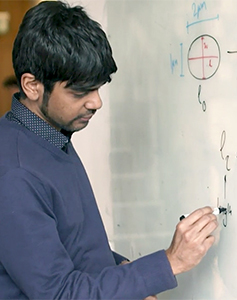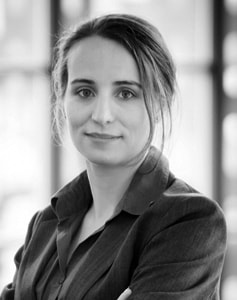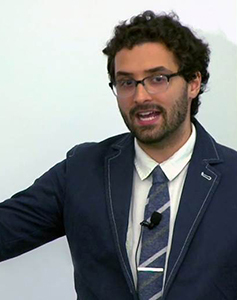New Faculty to Join CMU Physics in 2020
By Theresa Gabrielli
Astrophysics and Biological Physics Groups Gain Strength by Attracting Exciting Young Scholar-Teachers
It was a busy year for the whole CMU Physics department. In worldwide searches for talent, the Astrophysics & Cosmology and Biological Physics groups targeted the very best of their age groups to join the department as faculty. As a result, a stunning cadre of researchers sent their resumes and were evaluated by two selection committees, headed by Drs. Rachel Mandelbaum and Matthew Walker (Astrophysics) and Drs. Mathias Loesche and Markus Deserno (Biophysics).
Shiladitya Banerjee
Dr. Banerjee received his Ph.D. from Syracuse University in 2013, then spent three years as a Kadanoff-Rice Postdoctoral Fellow at the University of Chicago. He became a member of the Department of Physics & Astronomy at University College London in 2016, where he served as an Assistant Professor and a Group Leader. He will join the Theoretical Biological Physics faculty in 2020.
Ulrike Endesfelder
Dr. Endesfelder obtained her formal training in physics at the universities of Bonn (M.S.) and Bielefeld (Ph.D.) in Germany. She then trained as a post-doctoral researcher at the universities of Würzburg and Frankfurt and held research scholarships at Waseda University (Tokyo) and Stony Brook University. She joined the Max-Planck-Institute for Terrestrial Microbiology in 2014 where she currently holds the position as a Research Group Leader. She will join the Biological Physics group as CMU Physics faculty in early 2020.
Carl Rodriguez
A native of Shreveport, LA, Dr. Carl Rodriguez obtained his Ph.D. from Northwestern University. He has been a Pappalardo Postdoctoral Fellow at MIT since 2016, researching binary black holes, dense star clusters and gravitational waves. He will join the Astrophysics and Cosmology faculty in fall 2020 after completing a prestigious ITC Fellowship at Harvard University.
Dr. Shiladitya Banerjee
In his research, theoretical physicist Dr. Shiladitya Banerjee devises multi-scale models to explore how the internal structures of a living cell impacts its shape, mechanical properties, and ability to communicate with other cells. The shape and structure of a cell can have an integral impact on the cell’s function. As a cell grows, morphs, and reproduces, its components constantly reshape to adapt to changes in external and internal conditions. Understanding how these changes affect cells can aid in medical research and help medical professionals devise new therapies.
Shiladitya received his B.Sc. in Physics from the Chennai Mathematical Institute in India, then joined the graduate program at Syracuse University. Under the guidance of Christina Marchetti, he began to cultivate his interest and expertise in the physics of living systems. He was particularly intrigued by the mechanical properties of tissues, and how large colonies of cells interact within themselves as well as with outside stressors. His simulations predicted how individual cells within a tissue behave under physical forces like tension or compression.
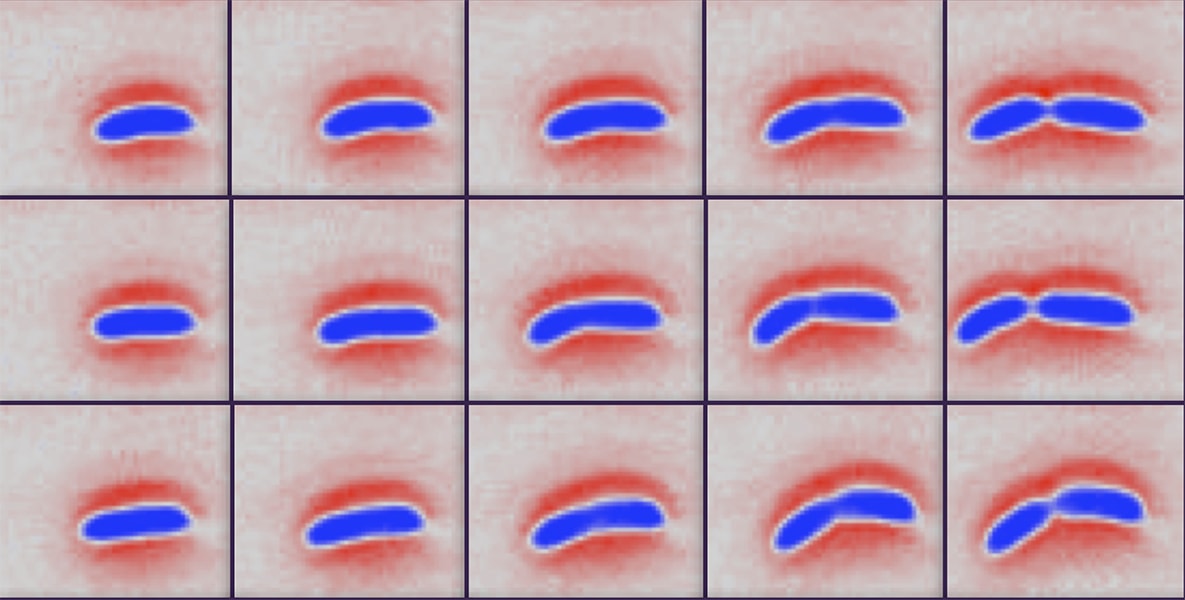
A rod-shaped bacterium growing and dividing, across three consecutive generations (top to bottom). Shiladitya developed a theoretical model for the control of size and shapes of these bacteria.
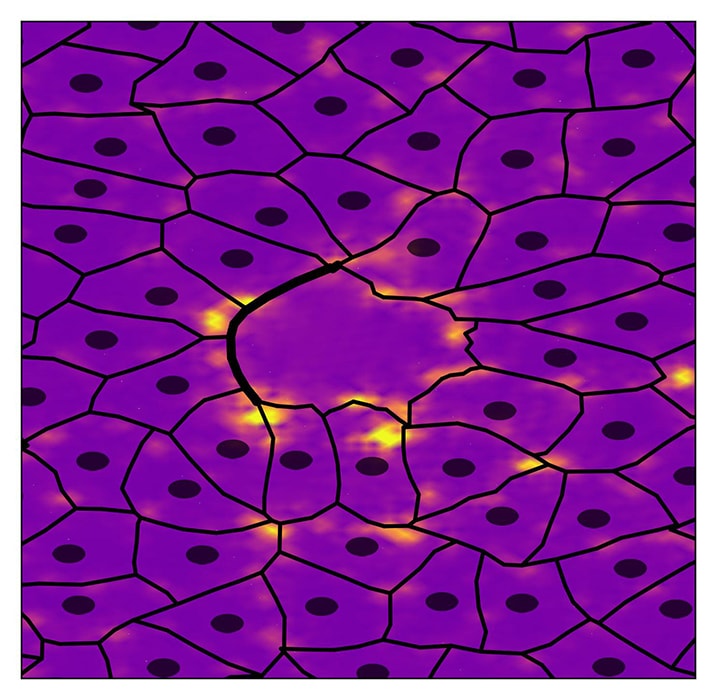
Simulation of a biophysical model of wound healing. The image shows a snapshot of wound closure, where the wound is surrounded by tissue cells. Color map indicates the physical forces exerted on the extracellular matrix by the tissue cells; warm colors indicate larger forces.
After obtaining his Ph.D. in 2013, he received a Kadanoff-Rice Postdoctoral Fellowship at the James Franck Institute at the University of Chicago, where he began to focus on cellular geometry. Living systems are stunningly complex, continually growing, changing and adapting. Ingeniously combining biological and mechanical modeling, Shiladitya was able to show that the mechanical form, function and regulatory biochemistry in living matter relate to that matter’s collective decision-making strategies. He found that the interplay between protein synthesis and cell mechanics regulates cell shape, division timing, and survival in stressed conditions.
Shiladitya has been with the Department of Physics & Astronomy at University College London (UCL) since 2016, where he is currently an Assistant Professor and the principal investigator and group leader for the Theory of Living Matter research group. At UCL, he studies how cell populations communicate and cooperate to repair damage. When, for example, a child falls and scrapes his knee, the cells within the wounded skin tissue must collectively rearrange themselves, divide to produce new tissue, and eliminate anything that could prevent healthy tissue formation. Using cell-based computational models, Shiladitya found that the rapid cell motion necessary for such healing is the result of back and forth tension and relaxation throughout the tissue.
Shiladitya is a recipient of the American Physical Society Prize for Outstanding Doctoral Thesis Research in Biological Physics, the Human Frontier Science Program (HFSP) Young Investigator Award, and the UK Engineering & Physical Sciences Research Council (EPSRC) New Investigator Award.
Dr. Ulrike Endesfelder
Early in her career, Dr. Ulrike Endesfelder explored several research fields. After formal training in physics and mathematics at the University of Bonn, she focused on radio astronomy and the analysis of molecular spectra from star-forming regions within the Milky Way, then investigated the magnetization behavior of ferrofluids under microgravity. She completed a Master's thesis in medical physics on laser osteotomy at Bonn in 2008, but still her curiosity was not satisfied.
Ulrike was excited by the then-new area of single-molecule biophysics and joined the research group of Prof. Kazuhiko Kinosita Jr. at Waseda University in Tokyo, where she studied the motions of molecular motors.
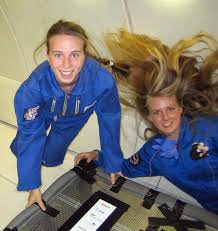
Ulrike (left) encounters microgravity in a parabolic flight during her training at University of Bonn.
The experience abroad was a game changer for Ulrike. Not only did she leave her mark in a traditionally male-dominated research environment, but she also propelled herself into the next stage of her career, in which she explored the rapidly developing area of super-resolution fluorescence microscopy. This exciting new technology enabled her to observe proteins and nucleic acids, the players of life, within living cells to reveal their localization, dynamics and interactions with other biomolecules. Back in Germany at the University of Bielefeld, she completed her Ph.D. under the guidance of Mike Heilemann in 2012.
Further honing her skills in laser spectroscopy and optical microscopy, she trained as a postdoctoral scholar in the Department of Biotechnology and Biophysics at the University of Würzburg, then in the Department of Physical and Theoretical Chemistry at the University of Frankfurt. Since 2014, she has been growing her own research group in an independent junior faculty position at the Max-Planck-Institute in Marburg with teaching assignments in Chemistry and Biophysics at Frankfurt University and the University of Marburg.
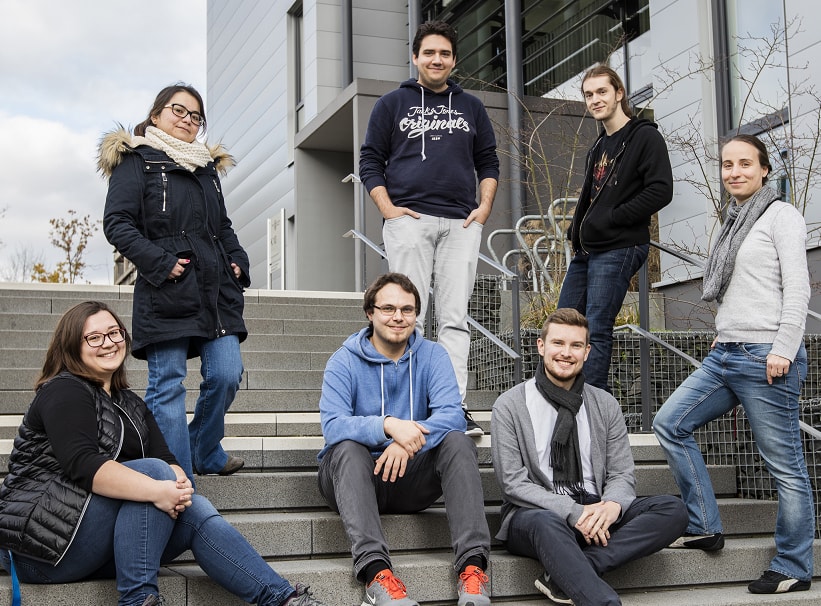
Ulrike’s research is centered on tool development – such as engineering and characterization of novel photo-switchable fluorophores and tracking algorithms for localization information in massive data sets – and functional studies of macromolecular complexes – such as her recent studies of the DNA surveillance mechanisms of CRISPR-Cas type I systems.
Ulrike is an elected member of the Young Academy associated with the German National Academy of Sciences Leopoldina and the Berlin-Brandenburg Academy of Sciences and Humanities.
Left: The Endesfelder research group at the Max Planck Institute for Terrestrial Microbiology in Marburg, Germany.
Dr. Carl Rodriguez
The concept of gravitational waves – ripples in the fabric of spacetime – had been theorized and interpreted by astrophysicists for a century, ever since Albert Einstein first predicted them as part of his theory of general relativity, but had never been observed directly.
In 2015, Carl Rodriguez, then still a graduate student and Ph.D. candidate at Northwestern University, was fascinated by the relationship between gravitational waves, stellar astrophysics, and cosmology. He postulated that the first gravitational wave detection would come, not from merging binary neutron stars or low-mass black holes as most of the astrophysics community expected, but from the merger of black holes within globular star clusters more massive than any observed in our own galaxy. In July of that year, he and his colleagues published a paper calculating the incidence of binary black hole mergers within globular clusters. The paper concluded that globular clusters were so common, and merger events happened so frequently, that they would produce significantly more opportunities to observe gravitational waves, making it highly likely that the first detection would come from such an event. Two months later, Carl was proven right.
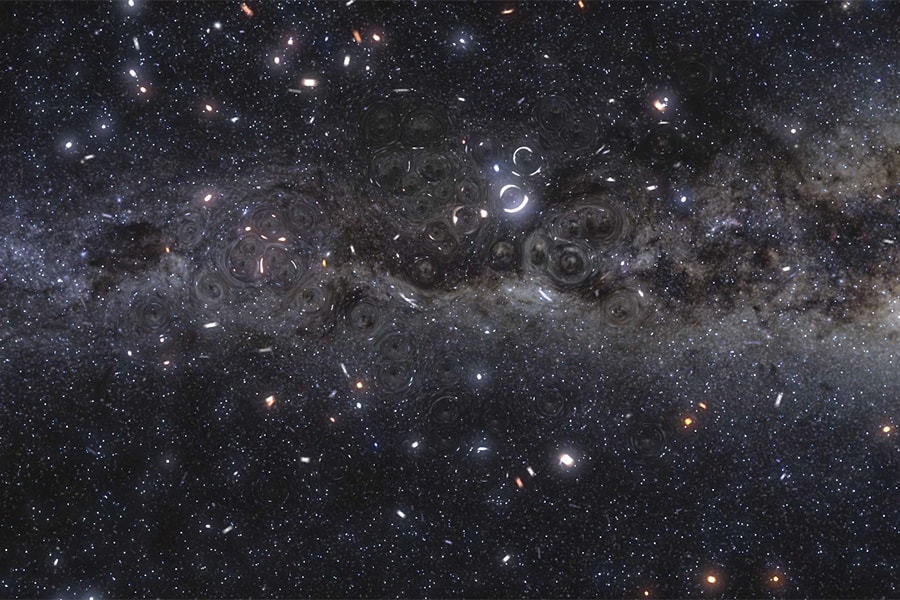
The gravitational interaction of many black holes in the core of a globular cluster.
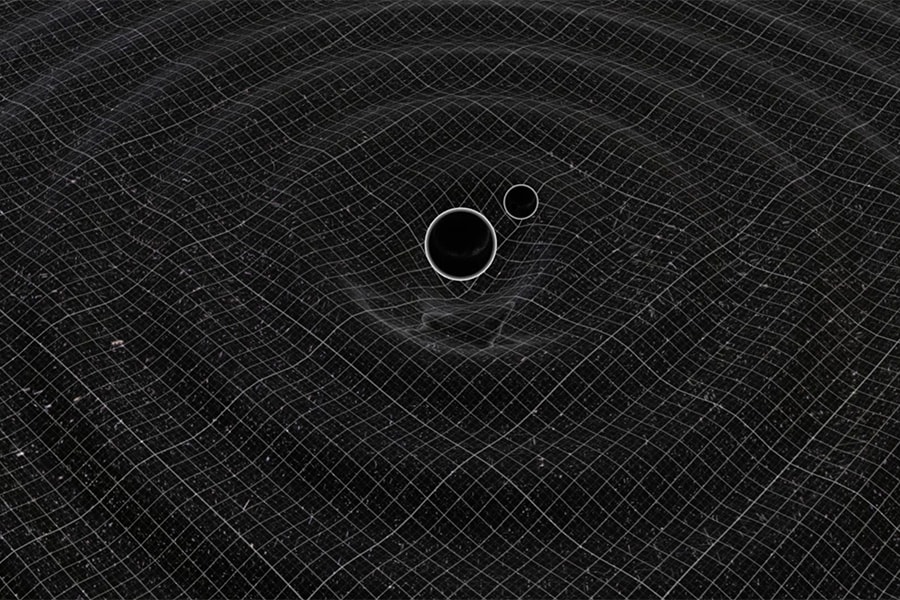
A model of gravitational waves - ripples in the fabric of spacetime - created from a merging binary black hole.
On September 14, 2015, the Laser Interferometer Gravitational-wave Observatory (LIGO) directly detected gravitational waves from a binary black hole merger. Astrophysicists around the world recognized the significance: gravitational waves carry with them information about what and where they came from. Continual detection and analysis of such information will allow us to map the precise locations of black holes throughout the universe, observe events too dark for us to see otherwise, and even revise our understanding of the nature of gravity. This was the beginning of the field of gravitational-wave astronomy, and Carl Rodriguez was at the forefront of it.
Carl continued to distinguish himself throughout his time at Northwestern, earning an NSF Graduate Research Fellowship, an NSF GK12 Fellowship, and two Illinois Space Grant Consortium Fellowships. Upon completion of his Ph.D. in 2016, he was offered a Pappalardo Postdoctoral Fellowship at MIT, where he has been working for the past three years.
His research investigates how gravitational waves encode the information they transmit, and looks toward the future of the field. Carl intends to bridge the gap between traditional theoretical astrophysics and gravitational wave physics, using astrophysical models in a cosmological context. Gravitational waves have the potential to answer enormous questions about the formation of black holes and the expansion of the universe, but only if we are able to interpret them correctly.
“Dr. Rodriguez is a leader in the quest to understand the sources of gravitational waves, and how to use the gravitational waves themselves as windows onto the physics of black holes,” said Associate Professor Matthew Walker. “We are thrilled that he will be joining us at CMU."
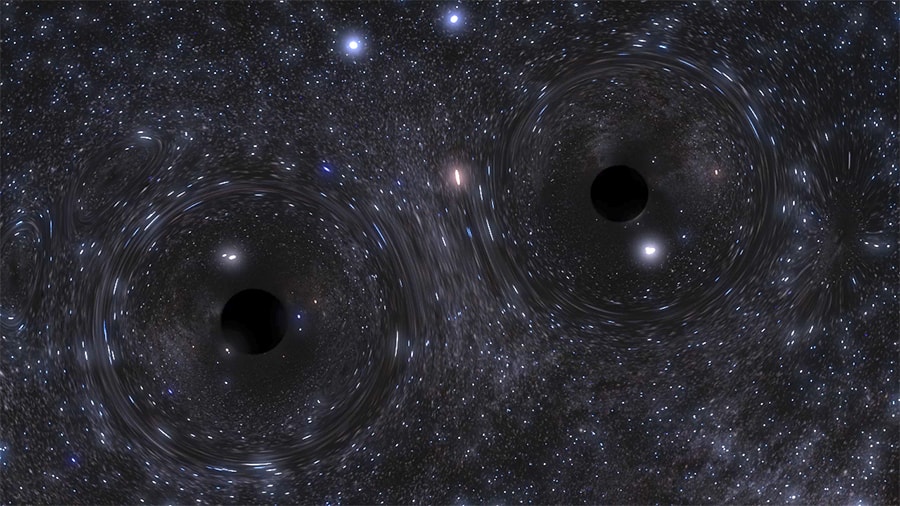
A black hole binary formed in the core of a dense star cluster. When binary black holes merge, they emit gravitational waves.
